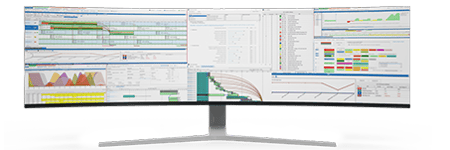
Mitigating the Impact of U.S. Tariffs with Advanced Planning and Scheduling (APS)
The recent months have brought unpredictable waves of change for global manufacturers. Among the most disruptive developments has been the implementation of U.S. tariffs—trade policy tools designed to protect domestic industries but often triggering unintended supply chain complexity, higher input costs, and shifting global sourcing strategies. As tariffs ebb and flow with policy shifts, manufacturers are caught in a state of flux, needing to adapt quickly without compromising performance.
To remain competitive and cost-effective under these conditions, manufacturers are increasingly turning to Advanced Planning and Scheduling (APS) systems. APS empowers organizations to respond nimbly to external shocks like tariffs, optimize their supply chains, and make smarter, data-driven decisions.
In this blog, we’ll explore how APS tools can serve as a critical strategic lever in mitigating the impact of U.S. tariffs on manufacturing operations.

Understanding the Tariff Challenge
Tariffs increase the cost of imported goods and materials—often significantly—disrupting established supply chain economics. Manufacturers that rely on foreign-sourced components are especially vulnerable. The challenges posed by tariffs typically fall into four categories:
Higher Input Costs: Tariffs can cause double-digit increases in raw material costs, squeezing already thin margins.
Supply Chain Disruption: Long-term supplier relationships can become unsustainable, forcing rapid sourcing changes.
Inventory Volatility: Uncertainty leads many companies to overstock or understock inventory, increasing carrying costs or risking shortages.
Production Reallocation: Tariffs may necessitate shifting production to other plants or countries, adding planning complexity.
In the face of these challenges, traditional ERP and spreadsheet-based planning tools are simply not agile or granular enough. This is where APS solutions come in.

Advanced Planning and Scheduling (APS) software can help manufacturers mitigate the impact of U.S. tariffs in several ways:
1. Optimized Sourcing and Procurement
APS can analyze different sourcing options and recommend suppliers from countries with lower or no tariffs.
It can help businesses dynamically shift procurement to avoid tariff-heavy imports.
2. Inventory and Supply Chain Optimization
APS enables just-in-time (JIT) inventory management to minimize the need for stockpiling tariffed goods.
It helps optimize warehouse locations and reduce storage costs by sourcing goods more strategically.
3. Cost and Pricing Adjustments
The software can model different tariff scenarios and suggest price adjustments to maintain profitability.
Manufacturers can use APS to optimize production costs and offset tariffs through more efficient operations.
4. Production Rescheduling & Capacity Planning
APS helps reschedule production to minimize dependency on imported materials subject to tariffs.
It can identify opportunities for reshoring or nearshoring production to avoid tariff costs.
5. Logistics and Route Optimization
APS can determine the most cost-effective transportation routes and methods to reduce tariff exposure.
It may suggest alternative ports of entry with lower tariffs or better trade agreements.
6. Scenario Analysis & Forecasting
APS software allows manufacturers to run what-if scenarios to predict the impact of new tariffs.
It helps make proactive adjustments before tariffs go into effect.
7. Regulatory Compliance & Trade Agreements
APS integrates with trade regulations to ensure compliance and maximize duty drawbacks or exemptions.
It can track free trade agreements (FTAs) and suggest alternative trade routes to minimize costs.
By leveraging APS software, manufacturers can adapt quickly, reduce costs, and maintain competitiveness despite tariff-related challenges.
In short, APS turns tariff compliance from a reactive, cost-focused headache into a proactive, strategy-driven advantage.
++++++++++++++++++++++++++++++++++++++++++++++++++++++++++++++
+++++++++++++++ESTO ES POR SI LO QUIERES ASI+++++++++++++++++++
How APS Helps Navigate Tariff Challenges
Let’s explore how APS provides a practical and powerful way to tackle each tariff-related challenge:
Scenario-Based Planning to Assess Tariff Impacts
APS platforms allow planners to create and compare multiple “what-if” scenarios. For instance:
What if aluminum from China becomes 25% more expensive overnight?
What if I shift production of a sub-assembly to a domestic supplier?
By adjusting variables such as supplier location, lead times, and material costs, APS can simulate the ripple effects across your entire supply chain—down to the production line. This enables decision-makers to pre-emptively shift sourcing strategies, adjust production schedules, or optimize batch sizes to minimize cost impacts.
Dynamic Supplier Reallocation
As tariffs render certain suppliers economically unviable, manufacturers often need to switch to alternative sources—sometimes with longer lead times or different reliability levels. APS systems can dynamically recalibrate schedules based on these supplier changes, balancing cost with on-time delivery.
For example, if a tariff increases the cost of a steel supplier in Mexico, APS might recommend shifting procurement to a domestic source with slightly higher base cost but no tariffs—while also adjusting production schedules to accommodate different delivery cycles.
Optimized Inventory and Safety Stock Planning
Tariff announcements often trigger panic buying or excessive safety stock accumulation. APS enables planners to calculate optimal inventory levels based on real-time data and forecasting. This ensures that manufacturers avoid costly overstocking or running out of critical components.
APS can also coordinate procurement timing with tariff implementation schedules. If a tariff is scheduled to increase in three months, APS can front-load material purchases—within warehouse capacity limits—to avoid cost spikes.
Multi-Plant and Global Production Optimization
Manufacturers with global footprints may be able to reroute production to facilities in tariff-free regions. APS helps evaluate and implement these changes quickly. For example:
A company with plants in the U.S. and Vietnam can use APS to simulate shifting high-tariff product lines to the Vietnamese facility.
APS evaluates labor availability, lead times, and shipping constraints to ensure that the transition maintains service levels.
By orchestrating complex multi-facility operations, APS reduces the risks associated with production migration.
Real-Time Alerts and Agile Rescheduling
Tariff regulations can change suddenly. APS systems offer real-time alerts and agile rescheduling capabilities, allowing planners to react within hours instead of days. This is critical when sudden duties are applied to in-transit goods or when compliance regulations change.
With drag-and-drop interfaces and automated scheduling engines, APS enables fast response times that help avoid missed deliveries, penalties, or customer dissatisfaction.
A Strategic Advantage Beyond Compliance
While APS is a powerful tool for mitigating tariffs, its benefits extend well beyond tariff management:
Increased On-Time Delivery: APS helps manage production priorities and constraints to ensure consistent delivery performance.
Higher Throughput: By minimizing downtime, optimizing changeovers, and leveling workloads, APS can increase capacity without capital investment.
Reduced Working Capital: Better inventory planning means less cash tied up in stockpiles.
Improved Customer Satisfaction: APS ensures that production plans align with customer commitments, even during external disruptions.
Building Resilience in a Tariff-Prone World
Whether driven by trade disputes, geopolitical tensions, or protectionist policies, tariffs are likely to remain a volatile factor in global manufacturing. To survive—and thrive—manufacturers must invest in tools that enable agility, visibility, and data-driven decision-making.
Advanced Planning and Scheduling systems offer just that. By transforming how manufacturers respond to input cost changes, supply shifts, and geopolitical disruptions, APS empowers them to:
Protect margins,
Ensure service levels, and
Build long-term resilience.
Rather than reacting to tariffs as a cost burden, manufacturers can reframe them as a catalyst for smarter operations.
Tariffs are more than a line item on your bill of materials—they’re a strategic force shaping the future of manufacturing. Advanced Planning and Scheduling is the key to turning that challenge into a competitive edge.